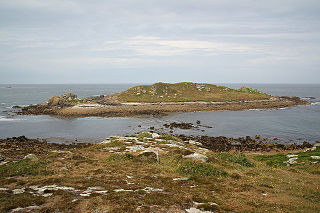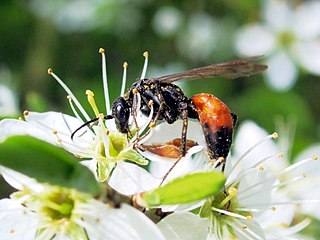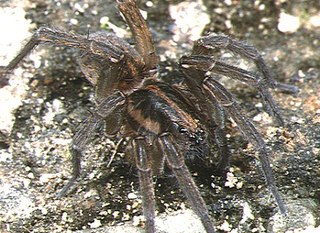A genus is a taxonomic rank used in the biological classification of living and fossil organisms, as well as viruses, in biology. In the hierarchy of biological classification, genus comes above species and below family. In binomial nomenclature, the genus name forms the first part of the binomial species name for each species within the genus.

Extinction is the termination of a kind of organism or of a group of kinds (taxon), usually a species. The moment of extinction is generally considered to be the death of the last individual of the species, although the capacity to breed and recover may have been lost before this point. Because a species' potential range may be very large, determining this moment is difficult, and is usually done retrospectively. This difficulty leads to phenomena such as Lazarus taxa, where a species presumed extinct abruptly "reappears" after a period of apparent absence.

The International Union for Conservation of Nature (IUCN) Red List of Threatened Species, founded in 1964, is the world's most comprehensive inventory of the global conservation status of biological species. It uses a set of criteria to evaluate the extinction risk of thousands of species and subspecies. These criteria are relevant to all species and all regions of the world. With its strong scientific base, the IUCN Red List is recognized as the most authoritative guide to the status of biological diversity. A series of Regional Red Lists are produced by countries or organizations, which assess the risk of extinction to species within a political management unit.

Wolf spiders are members of the family Lycosidae, from the Ancient Greek word "λύκος" meaning "wolf". They are robust and agile hunters with excellent eyesight. They live mostly in solitude and hunt alone, and do not spin webs. Some are opportunistic hunters pouncing upon prey as they find it or even chasing it over short distances. Some wait for passing prey in or near the mouth of a burrow.

The conservation status of a group of organisms indicates whether the group still exists and how likely the group is to become extinct in the near future. Many factors are taken into account when assessing conservation status: not simply the number of individuals remaining, but the overall increase or decrease in the population over time, breeding success rates, and known threats. Various systems of conservation status exist and are in use at international, multi-country, national and local levels as well as for consumer use.

An endangered species is a species that is very likely to become extinct in the near future, either worldwide or in a particular political jurisdiction. Endangered species may be at risk due to factors such as habitat loss, poaching and invasive species. The International Union for Conservation of Nature (IUCN) Red List lists the global conservation status of many species, and various other agencies assess the status of species within particular areas. Many nations have laws that protect conservation-reliant species which, for example, forbid hunting, restrict land development, or create protected areas. Some endangered species are the target of extensive conservation efforts such as captive breeding and habitat restoration.
In biology, a species is the basic unit of classification and a taxonomic rank of an organism, as well as a unit of biodiversity. A species is often defined as the largest group of organisms in which any two individuals of the appropriate sexes or mating types can produce fertile offspring, typically by sexual reproduction. Other ways of defining species include their karyotype, DNA sequence, morphology, behaviour or ecological niche. In addition, paleontologists use the concept of the chronospecies since fossil reproduction cannot be examined.

Trochosa ruricola is a wolf spider whose common name is rustic wolf spider. The females are 15 mm (0.6 in) but can reach 25 mm (1.0 in), and the males are 10 mm (0.4 in). Both sexes are dark brown and have a pale band that runs down to the carapace and continues to the abdomen.

The Norrard (Northern) Rocks are a group of small uninhabited granite rocks in the north–western part of the Isles of Scilly, to the west of Bryher and Samson. In 1971 they were designated as a Site of Special Scientific Interest (SSSI) for their breeding seabird colonies and they are permanently closed to landings from boat passengers. The vegetation on the islands is limited by the extreme exposure and only six species of flowering plants have been recorded.

Priocnemis perturbator is a relatively large species of spider wasp which is quite common in Europe. It was previously considered to be the same species as the closely related P. susterai which were lumped as P. fuscus and this means that some early observations of behaviour are not applicable to either species. Even now the two species need close observation under a microscope or hand lens to distinguish them from each other.

Trochosa is a large wolf spider genus found worldwide.
Trochosa robusta is a cellar spider species with Palearctic distribution. It is common in Germany and Poland. It remained unobserved, despite its considerable size, in Denmark until recently, where it was sighted on the island of Bornholm.
Anoplius infuscatus is a species of spider wasp found mainly in Eurasia.

Trochosa terricola is known as the ground wolf spider, is a wolf spider which is common and widespread in western and central Europe. It has been recorded as prey for the pompilid wasp.

Trochosa aquatica is a species of wolf spider found in eastern Asia which was first described in 1985.

Trochosa spinipalpis is a specialised species of Palearctic, wolf spider which is restricted to bogs and other wetlands.
Paracyphononyx is a genus of spider wasps distributed in the tropics and warmer temperate regions; they differ from other pompilids in that they do not permanently disable the host spider but allow the spider to resume activity after the wasp has laid its egg on the spider while the wasp larva exists as koinobiont ectoparasitoid of the spider.
Trochosa abdita is a spider in the family Lycosidae, in the infraorder Araneomorphae . It is found in the USA.
Trochosa sepulchralis is a species of wolf spider in the family Lycosidae. It is found in the United States.









